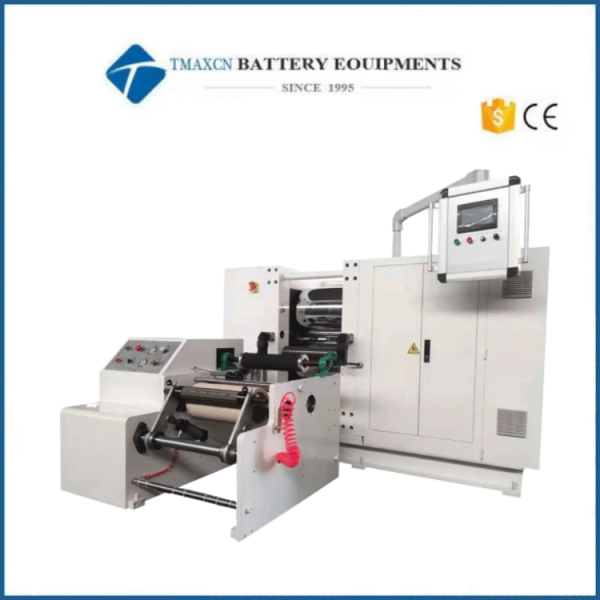- 메일 주소 : David@tmaxcn.com
- 메일 주소 : Davidtmaxcn@gmail.com
- : No. 39, Xinchang Road, Xinyang, Haicang Dist., Xiamen, Fujian, China (Mainland)
블로그
Dry Electrode Film Forming Machine
February 28,2025.
A Dry Electrode Film Forming Machine is a specialized piece of equipment used in the manufacturing of electrodes for lithium-ion batteries and other energy storage devices. This machine plays a crucial role in the production of dry electrode technology, which is gaining attention due to its potential to improve battery performance, reduce costs, and enhance sustainability.
---
●What is Dry Electrode Technology?
Traditional wet-coating methods for electrode manufacturing involve dissolving active materials in solvents (e.g., NMP - N-Methylpyrrolidone) to create a slurry, which is then coated onto a current collector and dried. In contrast, dry electrode technology eliminates the use of solvents by directly compressing a mixture of active materials and binders into a film.
This approach offers several advantages:
- Reduced environmental impact: No volatile organic compounds (VOCs) are emitted during the process.
- Lower cost: Eliminates the need for expensive solvents and drying processes.
- Improved safety: Reduces the risk of fire or explosion associated with flammable solvents.
- Enhanced performance: Allows for thicker electrodes, leading to higher energy density and longer cycle life.
---
●How Does a Dry Electrode Film Forming Machine Work?
The dry electrode film forming process typically involves the following steps:
1. Material Preparation:
- A dry powder mixture is prepared, consisting of active materials (e.g., lithium iron phosphate, graphite), conductive additives, and binders (e.g., polytetrafluoroethylene - PTFE).
- The proportions of these components are carefully controlled to achieve optimal performance.
2. Extrusion or Calendering:
- The dry powder mixture is fed into the machine and extruded or calendered under high pressure to form a continuous film.
- The machine applies mechanical force to compact the particles into a cohesive structure.
3. Lamination:
- The formed dry electrode film is laminated onto a current collector foil (e.g., aluminum for cathodes or copper for anodes).
- This step ensures good electrical contact between the active material and the current collector.
4. Cutting and Shaping:
- The laminated electrode film is cut into specific shapes and sizes according to the battery design requirements.
5. Quality Control:
- The machine may include sensors and monitoring systems to ensure uniform thickness, density, and adhesion of the electrode film.
●Key Components of a Dry Electrode Film Forming Machine
1. Feeding System:
- Responsible for evenly feeding the dry powder mixture into the machine.
2. Extrusion/Calendering Unit:
- Applies pressure to compact the powder into a film.
- May use rollers or dies to control the thickness and density of the film.
3. Lamination Unit:
- Bonds the dry electrode film to the current collector foil.
4. Cutting Mechanism:
- Cuts the laminated film into predefined shapes and sizes.
5. Control System:
- Monitors and adjusts parameters such as pressure, temperature, and speed to ensure consistent quality.
6. Safety Features:
- Includes safeguards to prevent overpressure, overheating, or material blockages.
---
●Advantages of Dry Electrode Film Forming Machines
1. Environmental Benefits:
- Solvent-free process reduces VOC emissions and waste.
2. Cost Efficiency:
- Lower material and energy costs compared to wet-coating methods.
3. Scalability:
- Suitable for large-scale production of high-performance batteries.
4. Flexibility:
- Can be adapted for various types of electrodes (cathodes and anodes) and battery chemistries.
5. Improved Battery Performance:
- Enables the use of thicker electrodes, which can increase energy density and reduce internal resistance.
---
●Challenges and Considerations
1. Uniformity:
- Ensuring consistent density and thickness across the entire electrode film can be challenging.
2. Binding Strength:
- Achieving strong adhesion between the dry electrode film and the current collector requires precise control of binder content and lamination conditions.
3. Equipment Complexity:
- Dry electrode film forming machines are more complex than traditional wet-coating equipment, requiring advanced engineering and calibration.
4. Material Compatibility:
- Not all active materials and binders are suitable for dry processing, so material selection is critical.
---
●Applications
Dry electrode film forming machines are primarily used in the production of:
- Lithium-ion batteries for electric vehicles (EVs), consumer electronics, and renewable energy storage systems.
- Solid-state batteries and other next-generation energy storage technologies.
Companies like Tesla have invested heavily in dry electrode technology, with their "Dry Battery Technology" being a key component of their battery innovation strategy.
---
●Conclusion
---
●What is Dry Electrode Technology?
Traditional wet-coating methods for electrode manufacturing involve dissolving active materials in solvents (e.g., NMP - N-Methylpyrrolidone) to create a slurry, which is then coated onto a current collector and dried. In contrast, dry electrode technology eliminates the use of solvents by directly compressing a mixture of active materials and binders into a film.
This approach offers several advantages:
- Reduced environmental impact: No volatile organic compounds (VOCs) are emitted during the process.
- Lower cost: Eliminates the need for expensive solvents and drying processes.
- Improved safety: Reduces the risk of fire or explosion associated with flammable solvents.
- Enhanced performance: Allows for thicker electrodes, leading to higher energy density and longer cycle life.
---
●How Does a Dry Electrode Film Forming Machine Work?
The dry electrode film forming process typically involves the following steps:
1. Material Preparation:
- A dry powder mixture is prepared, consisting of active materials (e.g., lithium iron phosphate, graphite), conductive additives, and binders (e.g., polytetrafluoroethylene - PTFE).
- The proportions of these components are carefully controlled to achieve optimal performance.
2. Extrusion or Calendering:
- The dry powder mixture is fed into the machine and extruded or calendered under high pressure to form a continuous film.
- The machine applies mechanical force to compact the particles into a cohesive structure.
3. Lamination:
- The formed dry electrode film is laminated onto a current collector foil (e.g., aluminum for cathodes or copper for anodes).
- This step ensures good electrical contact between the active material and the current collector.
4. Cutting and Shaping:
- The laminated electrode film is cut into specific shapes and sizes according to the battery design requirements.
5. Quality Control:
- The machine may include sensors and monitoring systems to ensure uniform thickness, density, and adhesion of the electrode film.
---
●Key Components of a Dry Electrode Film Forming Machine
1. Feeding System:
- Responsible for evenly feeding the dry powder mixture into the machine.
2. Extrusion/Calendering Unit:
- Applies pressure to compact the powder into a film.
- May use rollers or dies to control the thickness and density of the film.
3. Lamination Unit:
- Bonds the dry electrode film to the current collector foil.
4. Cutting Mechanism:
- Cuts the laminated film into predefined shapes and sizes.
5. Control System:
- Monitors and adjusts parameters such as pressure, temperature, and speed to ensure consistent quality.
6. Safety Features:
- Includes safeguards to prevent overpressure, overheating, or material blockages.
---
●Advantages of Dry Electrode Film Forming Machines
1. Environmental Benefits:
- Solvent-free process reduces VOC emissions and waste.
2. Cost Efficiency:
- Lower material and energy costs compared to wet-coating methods.
3. Scalability:
- Suitable for large-scale production of high-performance batteries.
4. Flexibility:
- Can be adapted for various types of electrodes (cathodes and anodes) and battery chemistries.
5. Improved Battery Performance:
- Enables the use of thicker electrodes, which can increase energy density and reduce internal resistance.
---
●Challenges and Considerations
1. Uniformity:
- Ensuring consistent density and thickness across the entire electrode film can be challenging.
2. Binding Strength:
- Achieving strong adhesion between the dry electrode film and the current collector requires precise control of binder content and lamination conditions.
3. Equipment Complexity:
- Dry electrode film forming machines are more complex than traditional wet-coating equipment, requiring advanced engineering and calibration.
4. Material Compatibility:
- Not all active materials and binders are suitable for dry processing, so material selection is critical.
---
●Applications
Dry electrode film forming machines are primarily used in the production of:
- Lithium-ion batteries for electric vehicles (EVs), consumer electronics, and renewable energy storage systems.
- Solid-state batteries and other next-generation energy storage technologies.
Companies like Tesla have invested heavily in dry electrode technology, with their "Dry Battery Technology" being a key component of their battery innovation strategy.
---
●Conclusion
Dry electrode film forming machines represent a significant advancement in battery manufacturing technology. By eliminating solvents and simplifying the production process, they offer numerous benefits in terms of cost, performance, and sustainability. As the demand for high-performance batteries continues to grow, this technology is likely to play an increasingly important role in the energy storage industry.
 ru
ru English
English











 +86 13174506016
+86 13174506016 David@tmaxcn.com
David@tmaxcn.com

